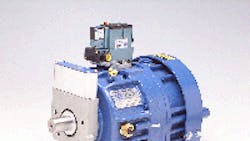Clutch brakes save energy with reduced starting currents
Posidyne clutch/brakes from Force Control Industries Inc. feature oil shear technology that allows rapid and precise stopping, starting, reversing, speed change, and positioning – without adjustment and requiring virtually zero maintenance. Suited for applications with frequent start and stop cycles, these motion control devices allow higher cycle rates (to 300 cycles per min), to increase production rates with less downtime. Faster production rates coupled with significantly longer service life than traditional (dry) clutch/brakes (5 to 10 times longer in many cases) yields increased uptime and productivity.
The clutch brakes are designed with low-inertia cycling components, which makes them more efficient, thus requiring less motor horsepower to accelerate the load, and less torque to stop it. Heat dissipation is also a major factor when selecting a clutch brake. The Posidyne clutch brake basic unit dissipates heat through the housing by flowing the fluid from the friction surface to the housing. Additional heat can be dissipated by adding an integral fan, water cooling, and even pulling the fluid out of the unit for additional heat exchanger cooling and filtration. These cooling options allow the same size clutch brake to be used on high inertia loads or in extremely high or low temperatures. Many mounting configurations are available, from standard foot mounting to piggyback or C-Face.
Posidyne clutch/brakes are used in diverse applications such as lumber mills, shingle plants, fiberglass insulation production, food processing, packaging, metalworking, and more. The totally enclosed clutch/brake is impervious to dust, chips, chemicals, coolants, caustic wash down, and weather, making them suitable for hostile environments.
A simple actuation system allows torque in the clutch and brake to be precisely controlled. Adjustment for rapid or soft starts and stops is easily accomplished, while manifold-mounted control valves reduce response times by eliminating hoses and fittings. By reducing the high starting inrush currents and the associated power factor imbalance, these clutch/brakes can also reduce energy costs.
The Posidyne clutch brake can be actuated either by air or hydraulic pressure for use in plant or outside applications. The hydraulic actuation package includes a hydraulic pump, solenoid valve, regulators, and a filter. A heat exchanger can be added for additional cooling. Multiple sizes are available to suit particular applications from ½ to 350 HP with cooling options, control logic, and mounting arrangements to simplify and speed installation.
Oil Shear Technology is the reason that brakes by Force Control do not need constant maintenance, adjustment, disc replacement, and last up to 10 times longer than standard dry friction brakes. Oil Shear Technology is the function of a boundary layer of transmission fluid in shear between the friction discs and drive plates. As the parts come together the fluid under shear will transmit torque between the two parts, as well as absorb heat. This eliminates direct contact of the friction discs and drive plates during high speed slip. Heat from the friction surface is dissipated as the fluid circulates to the housing.
For more information, contact Force Control Industries Inc., 3660 Dixie Highway, Fairfield, OH 45014. Phone: (513) 868-0900.
